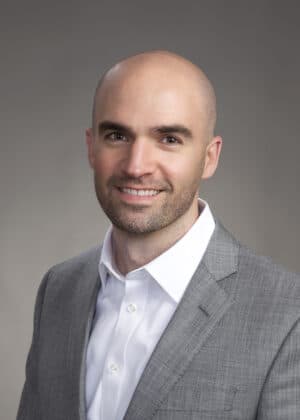Mark McGowan
Vice president and head of development, Boston, Oxford Properties Group
Age: 40
Industry experience: 18 years
Oxford Properties Group made a splash in 2014 with its big-ticket arrival in Massachusetts, buying five trophy office buildings in Boston and Cambridge, and now owns 4.5 million square feet of office space in the market. The next step for the Canadian pension fund investor: establishing a local development pipeline. To spearhead that effort, Oxford in 2018 hired Mark McGowan as its local head of development.
In his previous role at Skanska, McGowan was involved with developments including the Two Drydock office building in the Seaport District and the Harlo apartment tower in the Fenway. At Oxford, McGowan is leading the permitting of 125 Lincoln St., the proposed redevelopment of a parking garage as a 625,000-square-foot office tower. The Boston Planning and Development Agency has asked Oxford to reduce the height and width of the proposed 24-story tower to minimize shadows on the Rose Fitzgerald Greenway and surrounding Leather District and Chinatown neighborhoods.
Q: What’s the crux of your responsibilities at Oxford?
A: I’ve been at Oxford just under a year, and the role is to oversee development efforts. The idea was to establish a successful operating business and make sure the elevators are running up and down on time, and make sure we have the right people in the right roles, and expand that into creating new buildings and the ability to create a new pipeline for the Boston businesses.
Q: Braintree medical device maker Haemonetics recently moved its headquarters to your 125 Summer St. property. How much potential do Boston office towers have to attract more life science companies?
A: There are the obligatory physical constraints depending upon what the intensity of their science dictates. We were able to be creative and accommodate their needs at 125 Summer, but the existing stock has to check a few boxes: can they get enough air in and out through air exchange to do what they do? A lot of these businesses don’t need that, but need other infrastructure. It’s just having the conversation early.
Q: Did lab-ready infrastructure go into the designs for 125 Lincoln St.?
A: We’re just currently looking at the scoping determination that the city gave us and we’re preparing our response. It’s to be determined where we end up, but we’re exploring a lot of things. There’s a lot of interested parties: the Leather District community, Chinatown, the Greenway. The location is what we love about it and we wanted to get as many comments at once, so we can prioritize and respond.
Q: Do you intend to build the project on speculation?
A: We would if I had a building permit in hand right now. But truthfully where we are with the city and the community, we still have to figure out the right fit. I’d hate for the community to think we’re trying to jam something through. We have gotten interest from a lot of tenants.
Q: What accounts for the Back Bay office market’s quick recovery after the relocation of several large tenants to the Seaport and Financial District?
A: Serendipitously in the Back Bay, there’s a built-in residential community over there, there are awesome amenities, you’re close to transportation and you’re close to going west on the highway. It has so much to offer and it the press was writing that it had gone out of favor. The building stock was a lot older, but our neighbors and competitors down the street have done well with bringing in new companies. We’re full at 500 Boylston and 222 Berkeley St., and it’s a great location. What’s awesome about the city is we’re growing. North Station wasn’t a viable destination but Boston Properties and residential developers have put it on the map. As somebody who moved here in 2001, seeing how the city has grown has been awesome.
Q: What changes has Oxford made to the existing properties?
A: With tenants such as DraftKings and Wayfair, it’s selling a vision as companies want more from their buildings. The next step is how are we going to continuously make them better. We’ve done a lot of things to add life and vitality to lobbies and make them a third place: other places where people can meet a potential recruit or have a meeting. As we continuously think about ways to improve, that shows on our leasing tours. Companies like Haemonetics see the location and vibe and energy in the lobby and they gravitate toward that. The city needs more of that and the market is getting there. You could say the same thing at 225 Franklin St. We put Intelligentsia Coffee in the lobby, high tops and comfortable seating.
Q: Is Oxford looking to establish its own in-house coworking division or partner with an outside company?
A: We’ve been having a lot of conversations nationally. Locally, we just haven’t had the space [available] to repurpose for that kind of use, but it definitely serves an important part of the ecosystem. It gets back to what can building owners do better serve their clients, and flexibility is a great thing to have. There’s going to be a sliding scale of rent as people pay for flexibility.
McGowan’s Five Favorite Playgrounds for his Family
- Martin’s Park in Fort Point
- Hoyt Sullivan Park in Somerville
- Robbins Farm Park in Arlington
- Thomas M. Menino Park at Charlestown Navy Yard
- Esplanade Playground in Boston




 |
| 

